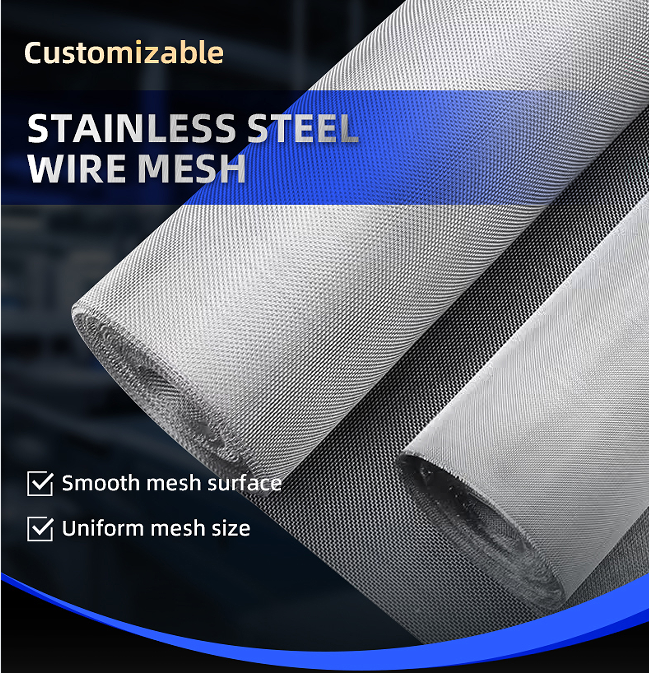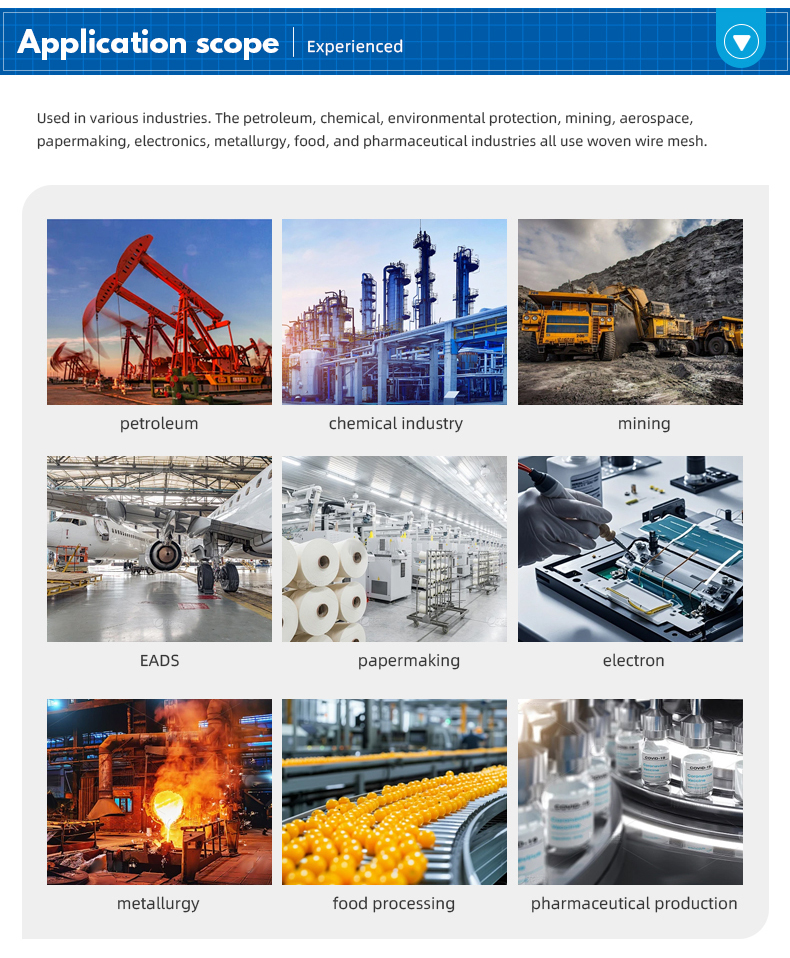Selection process and key points
Clearly define the core functional requirements
 1. Screening/filtering accuracy
1. Screening/filtering accuracy
-Particle/liquid particle size:
-Formula reference: Theoretical aperture=(1/mesh - wire diameter) × 25.4 (mm).
-Example: To filter 50 μ m particles, if a 100 mesh sieve is selected, the wire diameter must meet the requirement of 0.05mm ≤ wire diameter ≤ 0.154mm (theoretical pore size of 100 mesh is 0.154mm, and a coarse wire diameter will reduce the actual through-hole).
-Precision priority:
-High precision scenarios (such as medicine and electronics): Priority should be given to selecting fine wire diameters (0.05-0.3mm), paired with high mesh sizes (200-500 mesh).
-Rough screening scenarios (such as mining and construction): Choose a coarse wire diameter (1-3mm), with a mesh size typically ≤ 60 mesh.
-Screening rate and blockage risk:
-The fine wire diameter sieve has a high porosity rate (such as about 70% for a 100 mesh sieve with a diameter of 0.1mm), making it suitable for fine filtration; The coarse wire mesh has high strength and is suitable for processing large particles or high concentration materials (such as mineral sand screening).- 2. Load intensity
-Static load:
-Supporting scenarios (such as platform protective nets) require calculation of the tensile strength of the wire diameter:
-Example: 304 stainless steel (tensile strength 520MPa) can withstand a load of 500N with a safe wire diameter of ≥ 0.6mm.
-Dynamic load:
-Vibration screening scenarios (such as mining vibrating screens) need to consider impact force, and the wire diameter should be 20% -30% thicker than the static load
(such as 0.8mm for static and 1.0- 1.2mm for dynamic).
Analyze environmental conditions
- 1. Corrosive environment
-Weak corrosion scenarios (such as water treatment, air filtration):
-Optional 304 stainless steel, with wire diameter selected according to load requirements (usually 0.3-1mm).
-Strong corrosion scenarios (such as chemical and marine environments):
-316L stainless steel must be used, and a corrosion allowance must be left for the wire diameter:
-When the expected service life is more than 5 years, the wire diameter needs to be increased by 0.1-0.2mm (such as the standard wire diameter of 0.5mm, which is actually selected as 0.6-0.7mm).
-Case: 316L mesh with a wire diameter of 0.8mm (0.2mm thicker than freshwater) is used for seawater filtration to prevent breakage caused by chloride ion corrosion. - 2. High temperature environment
-Temperature resistant material matching:
-304 (≤ 800 ℃): The wire diameter should be 10% -20% thicker than at room temperature (e.g. 0.5mm for room temperature and 0.6-0.7mm for high temperature).
-310S (≤ 1150 ℃): High strength retention rate at high temperatures, wire diameter can approach room temperature values (such as a high-temperature sieve wire diameter of 1.0mm, which can be 0.9mm at room temperature under the same load).
-Thermal expansion effect:
-The expansion of the sieve mesh at high temperatures may cause changes in pore size, and a shrinkage allowance of 0.05-0.1mm should be reserved for the wire diameter (such as a design wire diameter of 1.0mm and a processing requirement of 1.05mm). - 3. Cleaning and maintenance requirements
-Easy to clog scenarios (such as viscous materials):
-Choose a coarse wire diameter (0.8-1.5mm) with a large aperture to reduce material retention; Alternatively, a serrated wire diameter (thick in the middle and thin at both ends) can be used to enhance self-cleaning ability.
-High frequency cleaning scenarios (such as the food industry):
-The surface roughness of the wire diameter should be ≤ Ra0.8 μ m, and the wire diameter tolerance should be ≤ ± 1% (such as a permissible error of ± 0.001mm for a wire diameter of 0.1mm) to avoid residual stains during cleaning.
Refer to industry standards and specifications
 1. General screening standards
1. General screening standards
-GB/T 5330-2003 (Industrial metal wire woven square hole sieve):
-Specify the range of wire diameters corresponding to different mesh sizes, such as:
-20 mesh sieve: wire diameter 0.8-1.0mm (304 material used for building screening);
-200 mesh sieve: wire diameter 0.071-0.10mm (316L material used for pharmaceutical filtration).
-ASTM E11 (American Testing Sieve Standard):
-The 40 mesh sieve has a wire diameter of 0.425mm (universal material), and the food industry needs to comply with the FDA's requirements for 316L material.- 2. Industry specific requirements
-Food and pharmaceutical industry (GMP/FDA certification):
-The wire diameter must be in the even micrometer range (such as 0.100mm, 0.150mm) for easy cleaning and verification; Prohibit the use of 201 stainless steel (risk of manganese precipitation).
-Aerospace/Electronics:
-The wire diameter tolerance is ≤± 0.5%, and the material needs to be 316L or titanium alloy. The wire diameter can be as fine as 0.02mm (such as chip photoresist filtration).
-Mining/Environmental Protection:
-Following the ISO 3310 standard, the wire diameter of the vibrating screen mesh needs to pass the abrasion resistance test (such as abrasion resistance index ≥ 150mg/5000 cycles), usually selecting a coarse wire diameter of 1.5-3mm.
Collaborative selection of material and wire diameter
- 1. Low cost scenarios (non corrosive, low load)
-Material: 201 stainless steel (tensile strength 630MPa).
-Wire diameter: Use high-strength characteristics to reduce wire diameter, such as using a 0.5mm wire diameter for decorative mesh (0.2mm thinner than 304 under the same strength), but avoid humid environments. - 2. High cost-effectiveness scenario (General Industry)
-Material: 304 stainless steel.
-Wire diameter:
-Mechanical protective net: 1.0-1.5mm (impact resistant);
-Liquid filtration: 0.3-0.8mm (balancing strength and filtration efficiency). - 3. Severe environmental scenarios (corrosion/high temperature/high precision)
-Material: 316L or 310S stainless steel.
-Wire diameter:
-Chemical corrosion environment: 0.6-1.0mm (0.1-0.2mm thicker than 304, compensating for corrosion losses);
-High temperature metallurgical screening: 1.2-2.0mm (310S material, resistant to high temperature creep).
Validation and optimization
 1. Sample testing
1. Sample testing
-Filtration efficiency test: Use the target material to test the sieving rate, which should be ≥ 95% (such as using a 100 mesh sieve to filter 50 μ m particles, and the pass rate should meet the standard).
-Life test: Simulate use in actual environments (such as running a vibrating screen for 500 hours), check the wear of the wire diameter (allowable wear ≤ 5% of the initial diameter).- 2. Cost balance
-Initial cost: The cost of fine wire mesh (such as 0.1mm) is 3-5 times that of coarse wire mesh (1.0mm) (due to high processing difficulty).
-Long term cost: In corrosive environments, the lifespan of 316L fine wire mesh (0.5mm) is more than twice that of 304 coarse wire mesh (0.8mm), resulting in lower overall cost.
Typical scenario selection example
| Application scenarios | Core requirements | Recommended materials | Wire diameter range | Selection criteria |
|---|---|---|---|---|
| Beverage clarification and filtration | Accuracy ≥ 100 mesh, acid and corrosion resistance | 316L |
0.10-0.15mm |
Fine wire diameter achieves high precision and is resistant to citric acid corrosion |
| Mining vibration screening | Impact resistant and wear-resistant | 304 |
1.5-2.5mm |
Coarse wire diameter can withstand ore impact, and 304 has low cost |
| High temperature kiln ventilation network | Resistant to high temperatures of 1000 ℃ and prevents particles from falling off |
310s |
1.0-1.8mm |
The material is resistant to high temperatures, and the coarse wire diameter prevents deformation at high temperatures |
| Laboratory precision screening | Accuracy ± 2%, easy to clean | 316L |
0.05-0.2mm |
Fine wire diameter with high mesh count, surface polished Ra ≤ 0.4 μ m |
Summary: Five step rule for selection
- 1. Specific function: Clarify the screening accuracy and load type (static/dynamic).
- 2. Environmental assessment: Analyze factors such as corrosion, temperature, and cleaning frequency.
- 3. Material selection: Determine the material based on the environment (304/316L/310S, etc.).
- 4. Calculate wire diameter: Calculate the theoretical value through a formula and adjust the margin based on experience.
- 5. Sample testing: Testing filtration efficiency, strength, and lifespan, optimizing selection.
- Through the above logic, it is possible to accurately match the requirements of the application scenario, avoiding low screening efficiency, equipment failure, or cost waste caused by improper wire diameter selection.







